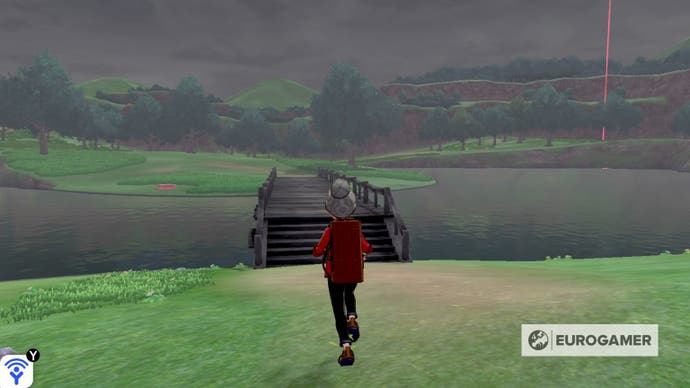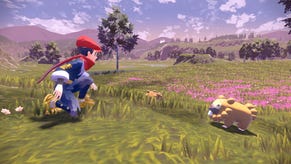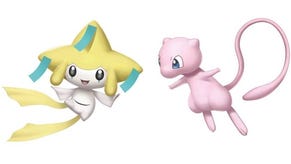Hands on with the enchanting first two hours of Pokémon Sword and Shield
Galarvanting around town.
Pokémon Sword and Shield open more or less the same as any other in the series: wake up in your room, chat with your mum, check the telly for a little Nintendo console reference. You know the story. Right the way through to the usual little fetch quest for the professor and battle with your rival, Sword and Shield's opening is a mostly pretty, sleepy, comfort-food affair. There's a little diversion in there, which I won't spoil, but really that aside it's business as usual.
Where things do change, though, is right after that. Not more than an hour or so into Sword and Shield you'll visit the Wild Area, and for that spot at least Pokémon's world finally opens up.
The Wild Area is a large, mostly grassy expanse in the middle of the Galar region's map. In it Pokémon roam freely on the overworld, like they do in all of Sword and Shield's long-grass areas, in a system similar to that of Let's Go. (There are now three types of encounter: visible, roaming Pokémon you walk into, traditional random encounters in the long grass, and "exclamation mark" encounters in long grass that you can either provoke for an encounter with a rarer Pokémon or sneak by to avoid.)
The significant difference with the Wild Area is, if you wander into the wrong part of it, you'll discover that the wild Pokémon can now be drastically overlevelled. It's a series first, and it honestly feels like the bravest thing Game Freak has done for a little while. You could always dip your toe into the odd higher-level route on the other side of a city, say, but never get caught in battle with a level 50, third-stage evolution 'mon with your starter and a level 6 Pidgey. In Sword and Shield it has a striking effect. It reminds me of some of the oldest games in the series where there was a real element of intimidation from some areas. Back then this was because of a fear of the unknown, and a spot of imagination filling in the blanks, but now it's because seeing a whopping great Pokémon five times your level is enough to intrigue and inspire.
I love when games do this: give you a taste of something far off to aim for, or to take care of when you come back, I love muttering something something "see you later" to a Snorlax I accidentally tussled with, that wiped out most of my underpowered team. I love having a glimpse of an unusual place I know I'll be back visiting again for more, or even a glimpse at more powerful moves I could have, with a kind of vendor in the Wild Area which it seemed I could grind out a dedicated currency for, if I really wanted to, and buy super-strong TMs with early on.

It's also just generally a surprising move away from the spoon-fed simplicity of more recent Pokémon games. It's clear the team at Game Freak have a real thing for making Pokémon as widely accessible as possible, with developers alluding to younger players not quite knowing where to go or what to do next in the past, and yet the Wild Area is one large, slightly disorientating mass of land, encountered surprisingly early in the game, that lets you take one wrong turn into a swathe of powerful enemies.
That's counteracted, though, with an updated map. There's now an objective marker on there and a little sentence in the top left reminding you what to do next - a pleasant quality-of-life update that's more about modernising Pokémon as an RPG than dumbing-down, don't worry - and it makes the Town Map a much more central part of your adventure than it has been in games gone past.
In terms of Pokémon Sword and Shield's challenge itself, it's obviously hard to judge given the slice of game that I played. I can tell you your first battle with your rival, coming straight after you choose your starter, as it always does, sees him have two Pokémon instead of one. It makes little difference - just use your single damage-dealing attack continuously, as always, and you'll beat them both - and being the very first battle of the game it's hardly a proper gauge of what's to come, but it's an interesting tweak nonetheless.

Wild Pokémon in the very early levels also inflict the odd status effect, and plenty of long grass patches are hard to sidestep entirely. Again, all very early-game stuff that it's difficult to extract much from, but I did find myself consciously thinking about what I was doing in those early stages, which is more than I can say for Pokémon's more recent RPGs gone by. Coupled with the Wild Area there does seem to be some early signs of acceptance from Game Freak that mainline Pokémon games need to keep older, longer-term players engaged, too.
Away from that, the only other main thing to be taken from my first hour or two with Sword and Shield is its charm. Pokémon Sun and Moon exemplified this in the previous generation, and the little moments of characterisation in Pokémon have become increasingly important to its wider appeal. Sword and Shield are no different, bringing lovely little touches of British slang - both endearingly accurate ("telly") and endearingly less so (sausage curry, and "you look fresher than a mint!") - as the early game parts of Galar feel like a hybrid of cosy northern homeliness and southern pomp.

Pokémon RPGs have lagged behind in pure visual fidelity for some time, even by Nintendo console standards, and technically Sword and Shield are no different. The frame rate seems stable enough, even in more dramatic battles like the Max Raid I tried out, which is a welcome improvement over latter-3DS era games like Ultra Sun and Ultra Moon, and the painterly backgrounds are considerably more intricate and evocative when you get playing than the slightly washed-out impression given off from trailers.
Unsurprisingly it's by far the most detailed Pokémon world there's been, and the early-game, Vicar of Dibley villages with their Pokémon Center pubs and shrub-lined fields have the kind of twinkly, primary colour palette that reminds me a little of Ni No Kuni. It's still no stirring hills of Breath of the Wild, though, and Sword and Shield's in-engine, unvoiced cutscenes pale somewhat compared to what contemporaries like Fire Emblem: Three Houses are doing with full on anime cinematics.
Character can go a long way though, and the best example of that is with the Pokémon themselves. The talk of "reused animations" from some of the more "vocal" parts of the fanbase is of course total hooey, with your starters watching on and fidgeting adorably as you um and arr between choosing them. Pokémon move around the wild with what feels like a little more flourish than the robotic back-and-forths of wild creatures in Let's Go, and knowing anything about the UK, or at least its more positive stereotypes, means plenty of little in-jokes and caricatures make for neat, oddly nostalgic touches as you look around. Local wildlife is also rather brilliantly imagined, with what seems like one of the largest suites of new Pokémon (I can't reveal them yet, sadly) making plenty of early appearances, and doing a wonderful job of romanticising Britain's somewhat mundane outdoors.

With new Pokémon come new systems, of course. Max Raid battles are the most striking, pitting you and three others - either AI trainers or ones found online - against a giant version of an otherwise rare Pokémon. Just interact with one of the glowing thingies in the Wild Area and you'll be thrown straight into one. The one I played was pretty simple - mashing whatever early game attacks I had against a jumbo Bunnelby - but there's potential there, I hope, for something more challenge in the late game. I did no prep for this one and my chosen Pokémon was knocked out pretty fast, but after a turn or two you get the chance to jump back into battle and it's over soon enough.
One of the most interesting additions is "very strong looking" Pokémon. If you remember Let's Go's small or large Pokémon, with their red or blue auras, it's a similar idea. A Pokémon with a (barely noticeable) yellow glow will appear on very, very rare occasions in the wild (I only saw two of them, and only in the Wild Area, myself) and you'll get a bit of flavour text when the battle starts noting their apparent strength. Rather than size, though, these have much more useful aspects: yellow-glowing 'mon have at least a couple of maximum IVs - the hidden gene-like stats that dictate how good one Machop is, say, compared to another - and they have Egg Moves rather than regular ones, too. It could potentially make looking for competitively viable Pokémon far easier - and more stimulating - than the usual breed or catch-everything-and-see grind, and could hopefully couple well with a mysterious new system that lets you boost your long-term party Pokémon up to competitive standards, too.

There's also a more fleshed-out character customisation system for those that enjoy it, which isn't particularly interesting to me but does afford a "make up" section for male characters, which I thought was a nice touch, even if it does just amount to changing eye colours or thickening eyebrows (microblading confirmed), and the sheer range of clothing options did at least make me think about caring about it, for once.
The take-away from it all, though is that Pokémon Sword and Shield haven't really been done justice with the Pokémon Company's apparent desire to keep much of it a secret. Galar as a region is genuinely enticing, far more than things like the smeary grey skies and bleak, industrial brown backgrounds of that initial starter reveal trailer suggest - even if they are authentically British. It's an unusual, somewhat mystical area, that feels riddled with the kind of enchanting old-age folklore that you can so easily forget the UK has, when it's been so long since your last school trip to some crumbling castle or celtic site of worship. It's also odd, seemingly challenging, and hopefully holding out on showing me more - in other words, it feels like Pokémon.










